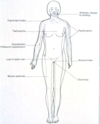7.13 Diagnosis of Adrenal Gland Disorders Flashcards
Describe the two major functional anatomy
They function as two independent systems
- THE ADRENAL CORTEX: steroid hormone synthesis
- THE ADRENAL MEDULLA: catecholamine synthesis
What are the major steroid hormones synthesised by the adrenal cortex?
- Glucocorticoids (cortisol)
- Mineralocorticoids (aldosterone)
What are the major catecholamines hormones synthesised by the adrenal medulla?
Adrenaline and noradrenaline
What are the disease states that involve the adrenal cortex?
- Cushing’s: overproduction of cortisol
- Addison’s: underprodution of cortisol
What is the major pathology involving the adrenal medulla?
Pheochromocytomas
Describe the histological features of the adrenal glands?
Medulla (the inside)
The Cortex: from outside to inside
- Glomerulosa
- Fasciculata
- Reticularis

Where in the cortex do each of the major steroids get synthesised?
Glomerulosa - mineralocoricoids and aldosterone
Fasciculata - glucocorticoids (cortisol) + some androgens
Reticularis - sex steroids, androgens + some cortisol

What is the structure of the steroid hormones?
They are all steroids from cholesterol
- Aldosterone & cortisol have the 4 ring structure common to all steroids
What is cortisol?
Cortisol = Also called Hydrocortisone
It is the endogenous hormone

What is cortisone?
Biological metabolite of cortisole/hydrocortisone, that is almost completely inactive
- Very weak glucocorticoid
- Metabolite of cortisol
What is aldosterone?
Another corticosteroid hormone which stimulates absorption of sodium by the kidneys and so regulates water and salt balance.
It is a Mineralocorticoid

What is the precursor molecule for the major corticosteroid hormones of the adrenal cortex: cortisol, aldosterone and sex hormones?
Describe the common pathway
Cholesterol
Cholesterol is converted to Pregnenolone
Three pathways from cholesterol, exist with each step tightly regulated such that the production of hormones is tightly controlled
Draw this pathway production of the corticosteroids

Will taking exogenous levels of the precursors in the synthesis pathway of corticosteroids increase the levels of the output hormones? Why or why not?
Because of the tight regulation, taking one of the precursers won’t necessarily increase the amount of the downstream hormones
What are the enzymes catalysing each step of the sythesis pathways for corticosteroids?

What are the four major actions of glucocorticoids?
It is especially important in times of acute stress - STRESS RESPONSE HORMONES to help maintain the body when homeostasis is challenged
- Stimulation of gluconeogenesis (liver)
- Mobilisation of amino acids (muscle)
- Stimulation of lipolysis (adipose tissues)
- Immunosuppression
What happens when there is an excess of cortisol in the body?
- weight gain
- wasting of muscle, skin and bone
- hyperglycaemia (muscle amino acid → glucose)
- hypertension (salt retention)
- Inhibition of linear growth
What are the two major types of hypercoritsolism?
- ACTH-dependent: when there is a problem with having too much stimulating hormone causing changes in cortisol production
- ACTH-independent: when there are normal levels of the trophic hormone but the adrenal cortex is producing too much cortisol
What are the major types of ACTH-dependent hypercortisolism?
- Pituitary adenoma (“Cushing’s disease”)
- Ectopic ACTH syndrome
What are the major ACTH-independent?
“Cushing’s syndrome”
- Adrenal adenoma or carcinoma
- ACTH-independent nodular hyperplasia
- Administration of glucocorticoids (common side effect of treatment)
Describe Cushing’s Disease
hyperadrenocortisolism (ACTH-dependent)
- hypertension
- apparent obesity
- muscle wasting, thin skin, metabolic derangements (eg. diabetes)
What are the signs of Cushing’s Syndrome?









